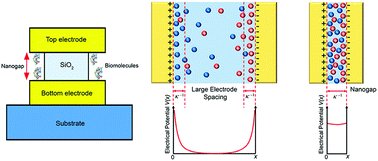A label-free aptamer-based nanogap capacitive biosensor with greatly diminished electrode polarization effects
Abstract
A significant impediment to the use of impedance spectroscopy in bio-sensing is the electrode polarization effect that arises from the movement of free ions to the electrode–solution interface, forming an electrical double layer (EDL). The EDL screens the dielectric response of the bulk and its large capacitance dominates the signal response at low frequency, masking information particularly relevant for biological samples, such as molecular conformation changes and DNA hybridization. The fabrication of nanogap capacitors with electrode separation less than the EDL thickness can significantly reduce electrode polarization effects and provide enormous improvement in sensitivity due to better matching of the sensing volume with the size of the target entities. We report on the fabrication of a horizontal thin-film nanogap capacitive sensor with electrode separation of 40 nm that shows almost no electrode polarization effects when measured with water and ionic buffer solutions, thereby allowing direct quantification of their relative permittivity at low frequencies. Surface modification of the electrodes with thiol-functionalized single strand DNA aptamers transforms the device into a label-free biosensor with high sensitivity and selectivity towards the detection of a specific protein. Using this approach, we have developed a biosensor for the detection of human alpha thrombin. In addition, we also examine frequency dependent permittivity measurements on high ionic strength solutions contained within the nanogap and discuss how these support recent experimental observations of large Debye lengths. A large shift in the Debye relaxation frequency to lower frequency is also found, which is consistent with water molecules being in a rigid-like state, possibly indicating the formation of an ordered “ice-like” phase. Altogether, this work highlights the need for better understanding of fluids in confined, nanoscale geometries, from which important new applications in sensing may arise.



 Please wait while we load your content...
Please wait while we load your content...